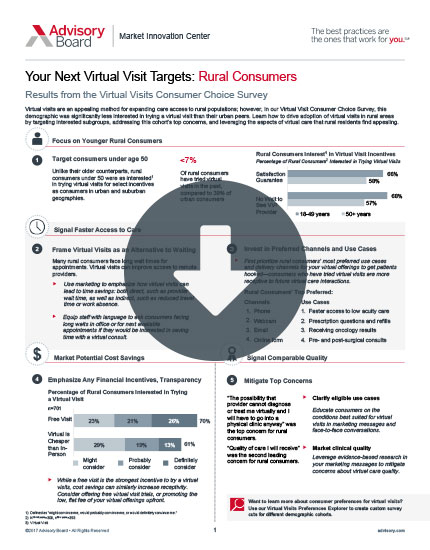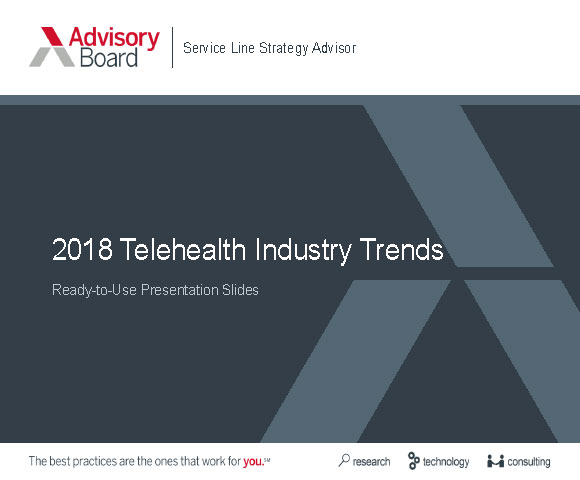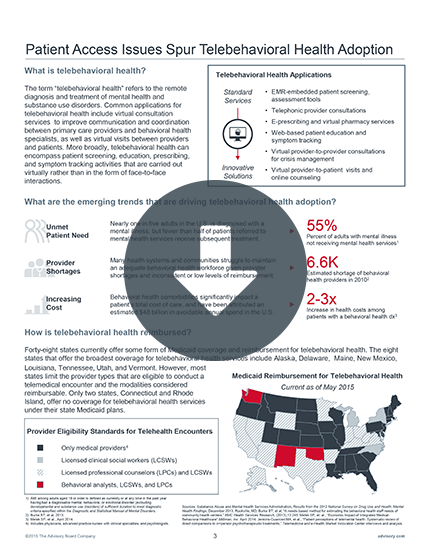Auto logout in seconds.
Continue LogoutTelemedicine has been touted as a way to increase access to care, particularly in rural areas, but a new study published in JAMA shows telemedicine users are more likely to live in cities rather than rural areas.
Where all 50 states stand on telehealth
Study details
For the study, researchers from the Harvard T.H. Chan School of Public Health analyzed claims from privately insured and Medicare Advantage enrollees in a "large, private U.S. health plan" from 2005-2017. The researchers did not identify the insurer associated with the data, which came from an OptumLabs Data Warehouse.
Daily Briefing is published by Advisory Board Research, a division of Optum, which is a wholly owned subsidiary of UnitedHealth Group.
Findings
The researchers found that telemedicine visits increased significantly from 2005 to 2017 among the claims—from 0.02 per 1,000 members to 6.57 per 1,000 members. The growth was especially significant between 2015 and 2017, which coincided with a number of states enacting parity laws that require insurers to cover telemedicine services, the researchers said.
The biggest growth was seen in mental health and primary care, which accounted for 53% and 39% of total telemedicine visits, respectively, the researchers found. They wrote, "By 2017, primary care telemedicine was the most frequently used form of telemedicine."
The patients who used primary care telemedicine generally were younger than those who used mental health telemedicine, and were more likely to live in urban areas. The researchers said that finding runs contrary to one of the biggest selling points of telemedicine: that it can reach patients living in rural areas where there may not be many physicians.
The researchers did find that mental health telemedicine usage increased most notably in counties without psychiatrists. However, when looking at primary care, the researchers found that "growth of primary care telemedicine was not associated with primary care physician supply, and there was a small negative association with comprehensive parity laws."
Overall, the researchers wrote that access to health care providers via telehealth is still "uncommon." But the researchers noted that their study was limited because they used data from only one health plan. In addition, the claims in the data generally were for younger enrollees who were more concentrated in the South than the rest of the U.S. population.
Discussion
Michael Barnett, assistant professor of health policy and management at the Harvard T.H. Chan School of Public Health, said the findings show reducing barriers to telemedicine could help drive use of such services. "Rural, low-supply areas have the highest telemental health demand and broad parity laws are associated with higher adoption," he said, adding, "Therefore, going further with reimbursement and lowering barriers may help telemental health expand."
But Barnett noted that, for primary care, "it's a totally different story with huge consumer adoption across the map." He said, "[W]e probably don't need any policy to influence that."
Todd Mahr from Gundersen Health System, said, "It is very exciting that in the last year, primary care visits increased dramatically due to improved coverage." Mahr added, "Hopefully there will be continued improvement in parity laws to bolster this trend" (Japsen, Forbes, 11/27; MacReady, Medscape, 11/27; Kuhrt, FierceHealthcare, 11/27; Rapaport, Reuters, 11/27).
Telehealth 101: Get the primer series
Need to get up to speed on the top issues in telehealth? Each installment in our primer series includes emerging trends, investment considerations, and case studies from top organizations, focusing on top areas such as:
Don't miss out on the latest Advisory Board insights
Create your free account to access 1 resource, including the latest research and webinars.
Want access without creating an account?
You have 1 free members-only resource remaining this month.
1 free members-only resources remaining
1 free members-only resources remaining
You've reached your limit of free insights
Become a member to access all of Advisory Board's resources, events, and experts
Never miss out on the latest innovative health care content tailored to you.
Benefits include:
You've reached your limit of free insights
Become a member to access all of Advisory Board's resources, events, and experts
Never miss out on the latest innovative health care content tailored to you.
Benefits include:
This content is available through your Curated Research partnership with Advisory Board. Click on ‘view this resource’ to read the full piece
Email ask@advisory.com to learn more
Click on ‘Become a Member’ to learn about the benefits of a Full-Access partnership with Advisory Board
Never miss out on the latest innovative health care content tailored to you.
Benefits Include:
This is for members only. Learn more.
Click on ‘Become a Member’ to learn about the benefits of a Full-Access partnership with Advisory Board
Never miss out on the latest innovative health care content tailored to you.



